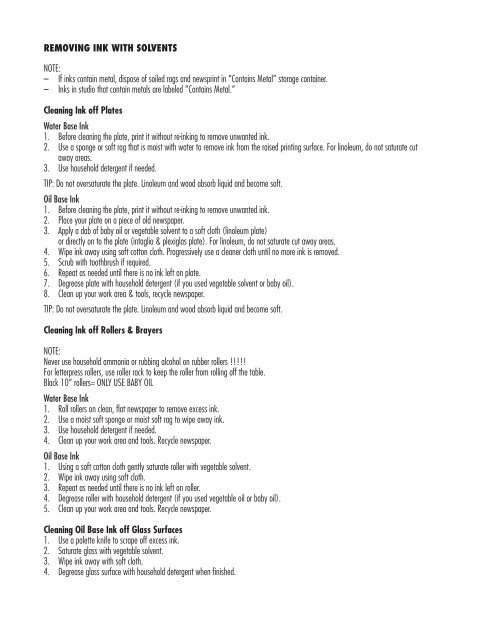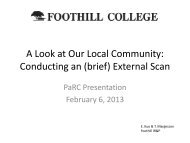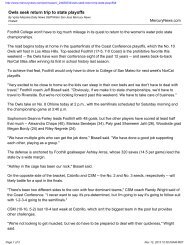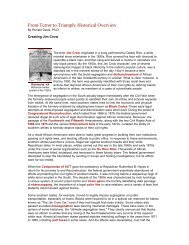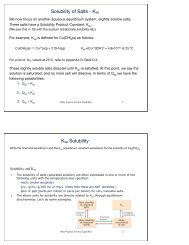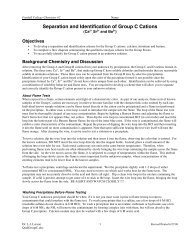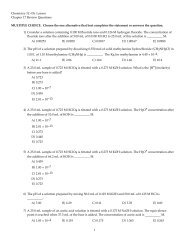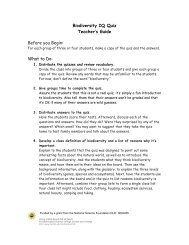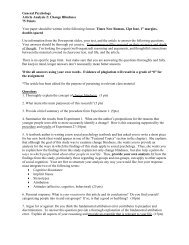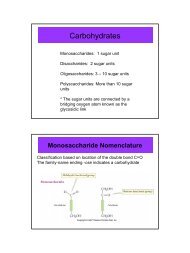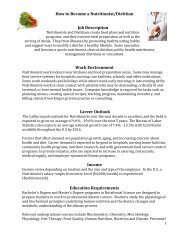REMOVING INK WITH SOLVENTS NOTE: – If inks contain metal ...
REMOVING INK WITH SOLVENTS NOTE: – If inks contain metal ...
REMOVING INK WITH SOLVENTS NOTE: – If inks contain metal ...
Create successful ePaper yourself
Turn your PDF publications into a flip-book with our unique Google optimized e-Paper software.
<strong>REMOVING</strong> <strong>INK</strong> <strong>WITH</strong> <strong>SOLVENTS</strong><br />
<strong>NOTE</strong>:<br />
<strong>–</strong> <strong>If</strong> <strong>inks</strong> <strong>contain</strong> <strong>metal</strong>, dispose of soiled rags and newsprint in “Contains Metal” storage <strong>contain</strong>er.<br />
<strong>–</strong> Inks in studio that <strong>contain</strong> <strong>metal</strong>s are labeled “Contains Metal.”<br />
Cleaning Ink off Plates<br />
Water Base Ink<br />
1. Before cleaning the plate, print it without re-inking to remove unwanted ink.<br />
2. Use a sponge or soft rag that is moist with water to remove ink from the raised printing surface. For linoleum, do not saturate cut<br />
away areas.<br />
3. Use household detergent if needed.<br />
TIP: Do not oversaturate the plate. Linoleum and wood absorb liquid and become soft.<br />
Oil Base Ink<br />
1. Before cleaning the plate, print it without re-inking to remove unwanted ink.<br />
2. Place your plate on a piece of old newspaper.<br />
3. Apply a dab of baby oil or vegetable solvent to a soft cloth (linoleum plate)<br />
or directly on to the plate (intaglio & plexiglas plate). For linoleum, do not saturate cut away areas.<br />
4. Wipe ink away using soft cotton cloth. Progressively use a cleaner cloth until no more ink is removed.<br />
5. Scrub with toothbrush if required.<br />
6. Repeat as needed until there is no ink left on plate.<br />
7. Degrease plate with household detergent (if you used vegetable solvent or baby oil).<br />
8. Clean up your work area & tools, recycle newspaper.<br />
TIP: Do not oversaturate the plate. Linoleum and wood absorb liquid and become soft.<br />
Cleaning Ink off Rollers & Brayers<br />
<strong>NOTE</strong>:<br />
Never use household ammonia or rubbing alcohol on rubber rollers !!!!!<br />
For letterpress rollers, use roller rack to keep the roller from rolling off the table.<br />
Black 10” rollers= ONLY USE BABY OIL<br />
Water Base Ink<br />
1. Roll rollers on clean, flat newspaper to remove excess ink.<br />
2. Use a moist soft sponge or moist soft rag to wipe away ink.<br />
3. Use household detergent if needed.<br />
4. Clean up your work area and tools. Recycle newspaper.<br />
Oil Base Ink<br />
1. Using a soft cotton cloth gently saturate roller with vegetable solvent.<br />
2. Wipe ink away using soft cloth.<br />
3. Repeat as needed until there is no ink left on roller.<br />
4. Degrease roller with household detergent (if you used vegetable oil or baby oil).<br />
5. Clean up your work area and tools. Recycle newspaper.<br />
Cleaning Oil Base Ink off Glass Surfaces<br />
1. Use a palette knife to scrape off excess ink.<br />
2. Saturate glass with vegetable solvent.<br />
3. Wipe ink away with soft cloth.<br />
4. Degrease glass surface with household detergent when finished.
Cleaning Ink off Metal Press Parts<br />
Never use water or household detergents!<br />
Use rubbing alcohol and cloth.<br />
Mineral spirits (paint thinner) can be used with instructor permission.<br />
Cleaning Ink off Brushes<br />
Water Base Ink<br />
1. Wipe off excess ink on newspaper.<br />
2. Wash with warm water and dishwashing soap.<br />
3. Rinse with warm water.<br />
<strong>NOTE</strong>:<br />
<strong>If</strong> any <strong>inks</strong> you used <strong>contain</strong> <strong>metal</strong>s, such as Titanium White, do not rinse in sink.<br />
Wash brush in solution from <strong>contain</strong>er labeled “Brush Cleaning Solution: May Contain Metals”.<br />
Oil Base Ink<br />
1. Wipe off excess ink on newspaper.<br />
2. Swish brushes sequentially in our four-<strong>contain</strong>er brush washing station.<br />
Container 1: Murphy’s Oil Soap & Water<br />
Container 2: Vegetable Oil<br />
Container 3: Dishwashing detergent & Water<br />
Container 4: Water<br />
3. Wash with warm water and dishwashing soap.<br />
4. Rinse with warm water.<br />
<strong>NOTE</strong>:<br />
Inform instructor if <strong>contain</strong>er contents are dirty and need replacement.<br />
Instructor will store spent solution in <strong>contain</strong>er labeled “Spent Brush Cleaning Solution” for recycling.


